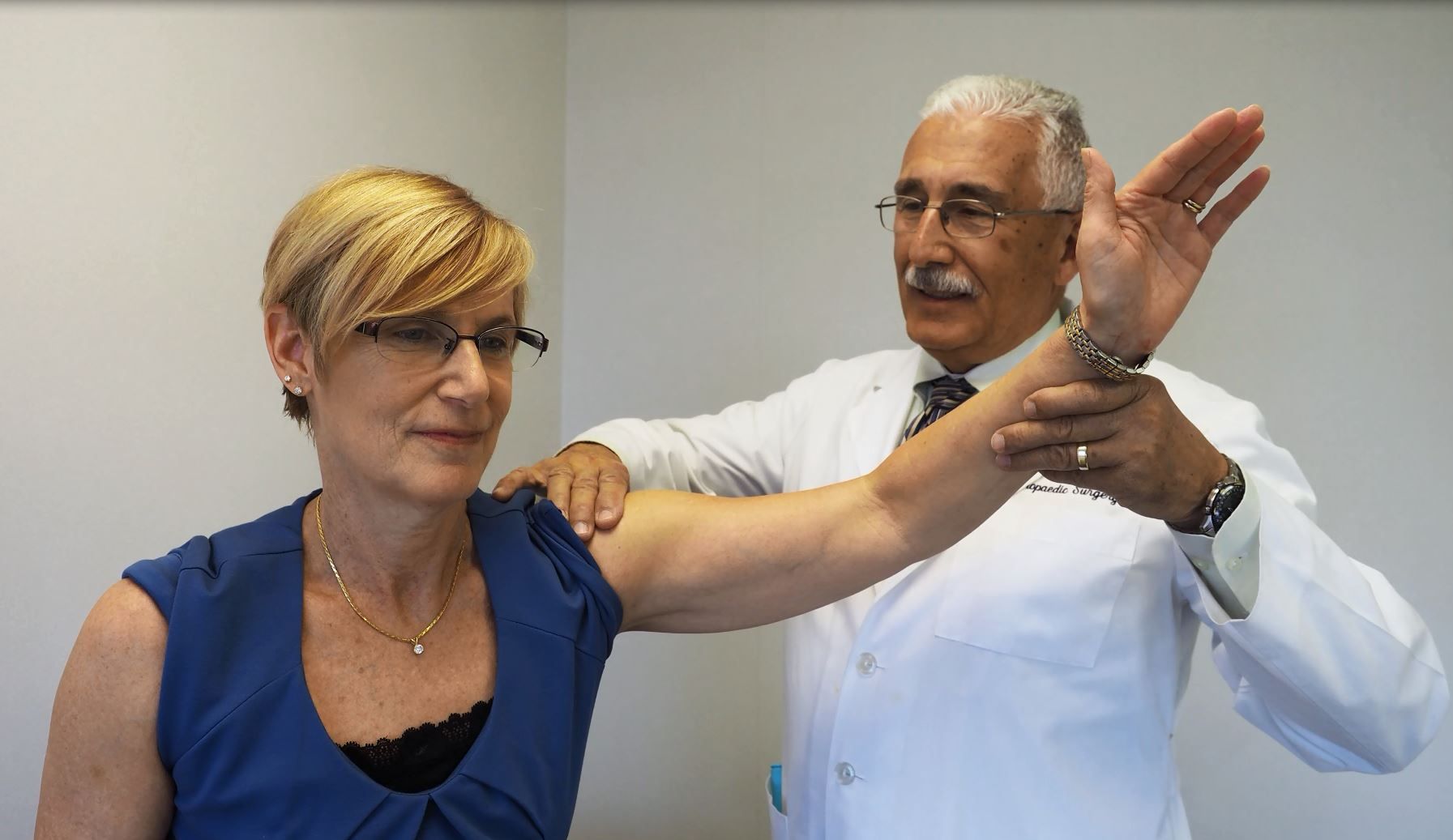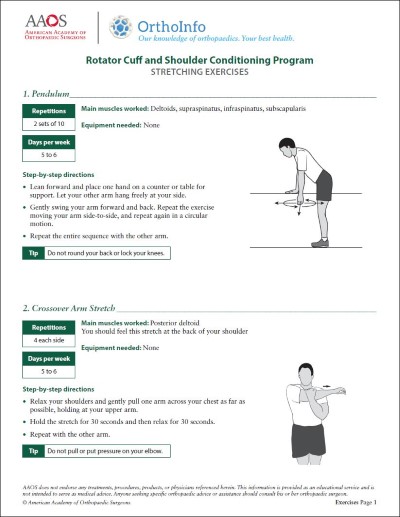Diseases & Conditions
Shoulder Pain and Common Shoulder Problems
What most people call the shoulder is really several joints that combine with tendons and muscles to allow a wide range of motion in the arm — from scratching your back to throwing the perfect pitch.
Mobility has its price, however. It may lead to increasing problems with instability or impingement of the soft tissue or bony structures in your shoulder, resulting in pain. You may feel pain only when you move your shoulder, or all the time. The pain may be temporary, or it may continue and require medical diagnosis and treatment.
This article explains some of the common causes of shoulder pain, as well as some general treatment options. Your doctor can give you more detailed information about your shoulder pain.
Anatomy
The shoulder is made up of three bones:
- The upper arm bone (humerus)
- The shoulder blade (scapula)
- The collarbone (clavicle)
The head of the upper arm bone fits into a rounded socket in the shoulder blade. This socket is called the glenoid. A combination of muscles and tendons keeps your arm bone centered in your shoulder socket. These tissues are called the rotator cuff. They cover the head of the upper arm bone and attach it to the shoulder blade.
Cause
Most shoulder problems fall into four major categories:
- Tendon inflammation (bursitis or tendinitis) or tendon tear
- Instability
- Arthritis
- Fracture (broken bone)
Other much less common causes of shoulder pain are tumors, infection, and nerve-related problems.
Bursitis
Bursae are small, fluid-filled sacs that are located in joints throughout the body, including the shoulder. They act as cushions between bones and the overlying soft tissues, helping to reduce friction between the gliding muscles and the bone.
Sometimes, excessive use of the shoulder leads to inflammation and swelling of the bursa between the rotator cuff and part of the shoulder blade known as the acromion. The result is a condition known as subacromial bursitis.
Bursitis often occurs in association with rotator cuff tendinitis. The pain and inflammation can make many daily activities, such as combing your hair or getting dressed, difficult.
Tendinitis
A tendon is a cord that connects muscle to bone. Tendinitis is a result of inflammation in the tendon.
Generally, tendinitis is one of two types:
- Acute. Excessive ball throwing or other overhead activities during work or sport can lead to acute tendinitis.
- Chronic. Degenerative diseases like arthritis or repetitive wear and tear due to age, can lead to chronic tendinitis.
The most commonly affected tendons in the shoulder are the four rotator cuff tendons and one of the two biceps tendons. The rotator cuff is made up of four small muscles and their tendons that cover the head of your upper arm bone and keep it in the shoulder socket. Your rotator cuff helps provide shoulder motion and stability.
Learn more: Biceps Tendinitis, Shoulder Impingement/Rotator Cuff Tendinitis
Tendon Tears
Splitting and tearing of tendons may result from:
- Acute injury
- Degenerative changes in the tendons due to advancing age, long-term overuse, or wear and tear
These tears may:
- Be partial (only go through part of the tendon thickness)
- Completely separate the tendon (pull it away) from where it attaches to bone
Rotator cuff and biceps tendon injuries are among the most common of these injuries.
Learn more: Rotator Cuff Tears, Biceps Tendon Tear at the Shoulder
Impingement
Shoulder impingement occurs when the top of the shoulder blade (acromion) puts pressure on the underlying soft tissues when the arm is lifted away from the body. As the arm is lifted, the acromion rubs, or "impinges" on, the rotator cuff tendons and bursa. This can lead to bursitis and tendinitis, causing pain and limiting movement.
Learn more: Shoulder Impingement/Rotator Cuff Tendinitis
Instability
Shoulder instability occurs when the head of the upper arm bone is forced out of the shoulder socket. This usually happens initially as a result of a sudden injury, but it can become chronic.
- Shoulder dislocations can be partial, with the ball of the upper arm coming just partially out of the socket. This is called a subluxation.
- A complete dislocation means the ball comes all the way out of the socket.
Once the ligaments, tendons, and muscles around the shoulder become loose or torn, dislocations can occur repeatedly. Recurring (repeated) dislocations, which may be partial or complete:
- Cause pain and unsteadiness when you raise your arm or move it away from your body
- Lead to an increased risk of developing arthritis in the joint
Learn more: Chronic Shoulder Instability, Shoulder Dislocation
Arthritis
Shoulder pain can also result from arthritis. There are many types of arthritis. The most common type of arthritis in the shoulder is osteoarthritis, also known as wear-and-tear arthritis. Symptoms such as pain and stiffness typically begin during middle age. Osteoarthritis develops slowly and the pain it causes worsens over time.
Osteoarthritis may be related to sports or work injuries or chronic wear and tear. Other types of arthritis can be related to rotator cuff tears, infection, or an inflammation of the joint lining.
Often people will avoid shoulder movements to try to lessen arthritis pain. This sometimes leads to a tightening or stiffening of the soft tissue parts of the joint, resulting in a painful restriction of motion.
Learn more: Arthritis of the Shoulder
Fracture
Fractures are broken bones. Shoulder fractures commonly involve the clavicle (collarbone), humerus (upper arm bone), and scapula (shoulder blade).
Shoulder fractures in older patients are often the result of a fall from standing height. In younger patients, shoulder fractures are often caused by a high-energy injury, such as from a motor vehicle collision or contact sports impact (like a football tackle or crashing into the boards in hockey).
Fractures often cause severe pain, swelling, and bruising about the shoulder.
Learn more: Shoulder Trauma (Fractures and Dislocations)
Doctor's Examination
- In the case of an acute injury causing intense pain, seek medical care as soon as possible.
- If the pain is less severe, it may be safe to rest a few days to see if time will resolve the problem. If symptoms persist, see a doctor.
Your doctor will conduct a thorough evaluation to determine the cause of your shoulder pain and provide you with treatment options.
Medical History
The first step in the evaluation is a thorough medical history. Your doctor may ask:
- How and when the pain started
- Whether the pain has occurred before and, if so, how it was treated
- Other questions to help determine both your general health and the possible causes of your shoulder problem
Because most shoulder conditions are aggravated by specific activities, and relieved by specific activities, a medical history can be a valuable tool in finding the source of your pain.
Physical Examination
A comprehensive examination will be required to find the causes of your shoulder pain. Your doctor will:
- Look for physical abnormalities, swelling, deformity, and/or muscle weakness
- Check for tender areas
- Observe your shoulder range of motion and strength
Tests
Your doctor may order specific tests to help identify the cause of your pain and any other problems.
- X-rays. X-rays will show any injuries to the bones that make up your shoulder joint.
- Magnetic resonance imaging (MRI) scans and ultrasound. These imaging tests create better pictures than X-rays of soft tissues. MRI may help your doctor identify injuries to the ligaments and tendons surrounding your shoulder joint.
- Computed tomography (CT) scan. A CT scan combines X-rays with computer technology to produce a very detailed view of the bones in the shoulder area.
- Electrodiagnostic testing. Your doctor may order a test, such as an electromyography (EMG), to evaluate nerve function.
- Arthrogram. During this X-ray study, dye is injected into the shoulder to better show the joint and its surrounding muscles and tendons. It may be combined with an MRI or CT scan.
- Arthroscopy. In this surgical procedure, your doctor looks inside the joint with a fiber-optic camera. Arthroscopy may show soft tissue injuries that are not apparent from the physical examination, X-rays, and other tests. In addition to helping find the cause of pain, arthroscopy may be used to treat the problem.
Treatment
Activity Changes
Treatment generally involves:
- Rest
- Altering your activities
- Physical therapy to help you improve shoulder strength and flexibility
Common sense solutions, such as not overdoing activities in which you normally do not participate, can help to prevent shoulder pain.
Medications
- Your doctor may prescribe medication to reduce inflammation and pain. If medication is prescribed to relieve pain, it should be taken only as directed.
- Your doctor may also recommend injections of numbing medicines or steroids to relieve pain.
Surgery
Surgery may be required to resolve some shoulder problems. However, most patients with shoulder pain will respond to simple treatment methods such as altering activities, rest, physical therapy, and medication.
Certain types of shoulder problems, such as recurring dislocations and some rotator cuff tears, may not benefit from exercise. In these cases, surgery may be recommended fairly early.
Surgery can involve arthroscopy to remove scar tissue or repair torn tissues, or traditional open procedures for larger reconstructions or shoulder replacement.
Last Reviewed
January 2024
Contributed and/or Updated by
AAOS does not endorse any treatments, procedures, products, or physicians referenced herein. This information is provided as an educational service and is not intended to serve as medical advice. Anyone seeking specific orthopaedic advice or assistance should consult his or her orthopaedic surgeon, or locate one in your area through the AAOS Find an Orthopaedist program on this website.








